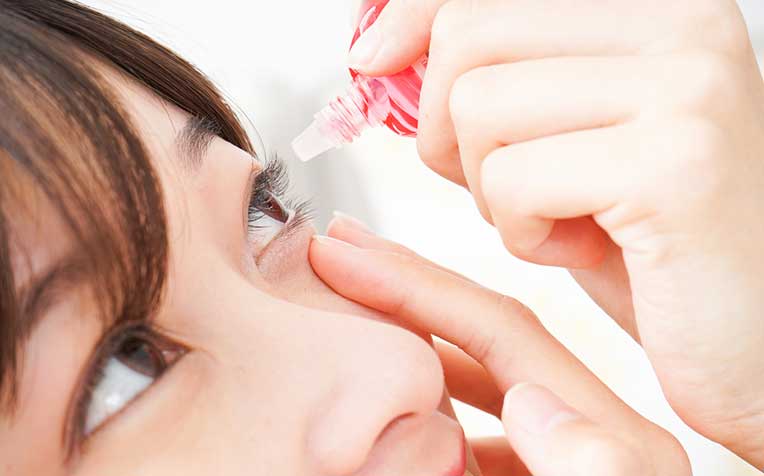
Dry eye (dry eye syndrome) can be relieved with lubricating eye drops, but be sure to follow the usage instructions provided.
When your eyes do not produce enough tears to lubricate the surface, it will result in dry eye, known medically as
dry eye syndrome, a condition that becomes more common as a person grows older. This is especially so for those aged 50 years and above.
Dr Woo Jyh Haur, Senior Consultant, from the Corneal & External Eye Disease Department at
Singapore National Eye Centre (SNEC), a member of the
SingHealth group, shares tips to help you in preventing your condition from worsening.
Tips for coping with dry eye (dry eye syndrome)
Tip 1: Take frequent eye breaks
Follow the
20-20-20 rule by taking an eye break every 20 minutes and looking at a distant object 20 feet away for 20 seconds when reading or looking at digital devices. This will help to relieve your eye strain. Blink your eye more frequently to help spread your tears evenly over the surface of your eyes.
Tip 2: Avoid having air blowing in your eye
Try not to allow air from a hair dryer, air-conditioner or fan to blow directly at your eyes. Use a humidifier to increase the relative humidity when indoors to keep your eye comfortable.
Tip 3: Refrain from smoking
Smoking increases your chances of getting dry eye. Try to stay away from people who smoke to prevent irritation and damage to your eye.
Tip 4: Consume food that are rich in omega-3 fatty acids
Food that are
rich in omega fatty acids such as salmon, sardines, herring, tuna and flaxseeds, may reduce inflammation which contributes to dry eye symptoms.
Home remedies for dry eye (dry eye syndrome)
Besides the above-mentioned tips, there are several home remedies you can try for relief of mild dry eye.
If the eyeball surface has not been damaged, lubricants from a pharmacy can be used. Be sure to follow the usage instructions provided.
Lifestyle adjustments can prevent dry eye syndrome from worsening. Some of these are reducing the use of contact lenses, lowering the height of computer monitors, limiting one’s exposure to air-conditioning, and spending less time gazing at screens.
Take care of your eyelids. Gentle warm compresses on the eyes may help release the oil from the glands in your eyelids and improve the quality of your tear film. Carefully cleaning your lids with specially formulated cleansers and rinse thoroughly after.
See an ophthalmologist. An ophthalmologist can advise on whether the condition is an ocular and systemic disease, drugs that can aggravate dry eyes, and what can be done in those circumstances.
Common causes of dry eye (dry eye syndrome)
Dry eye causes discomfort and in some instances vision problems too and could be due to:
Insufficient tears.
Tears are produced by several glands above your eyes. When there is a decrease in tear production or tears evaporate too quickly from the eyes, dry eye symptoms can develop.Poor quality of tears.
Tears are made up of three layers namely oil, water and mucus. A smooth oil layer helps keep your tears from drying up too quickly, while the watery layer in the middle washes away foreign particles and cleans the eye. The mucus layer helps spread the watery layer over the eye surface to keep it moist. Deficiencies with any of these three tear layers will lead to dry eye.
How tears help to protect our eyes
Tears are not just emotional indicators comprising salty water. They are a complex mixture of oil, water and mucus, created by three different “production factories” in the eye for its own benefit.
The mucus is made by microscopic goblet cells in the conjunctiva and the water layer by the lacrimal gland under the orbital rim bone, just below the eyebrow. The outermost layer, oil, is provided by the meibomian glands that line the edges of the eyelids. This mixture coats the entire surface of the eye, cleaning, lubricating and nourishing it throughout the day and protecting it from infection.
Sufficient quality and quantity of tears are essential for good vision, as they maintain a healthy and clear refractive surface. When there are not enough tears, or when the tears don’t have the correct mix of oil, water and mucus, the condition called dry eye syndrome occurs.
Risk factors for dry eye (dry eye syndrome)
Your risk of getting dry eye increases if you are:
Female. Women are more likely to develop dry eye due to hormonal changes caused by pregnancy or menopause
Diagnosed with certain medical conditions such as rheumatoid arthritis, diabetes, Grave’s disease, blepharitis, inflammation of the surface of the eye, or eyelid problems that causes the eyelid to turn inward and outward.
On medication for heart problems, high blood pressure (hypertension), allergies, heartburn or anxiety
Reading or staring at a computer screen or digital device for a long time and failure to blink your eye regularly
Wearing contact lenses for long periods of time
Indoors in an air condition environment which reduces humidity
Travelling on airplanes where the air in the cabin is very dry
Smoking. Tobacco from the cigarette irritates the protective layer of your eye known as the conjunctiva
Undergoing LASIK procedure. Dry eye after LASIK is usually temporary and will resolve on its own after a few weeks
Not consuming enough Vitamin A in foods like carrots, broccoli and liver or omega-3 fatty acids in fish, walnuts and vegetable oil
Symptoms of dry eye (dry eye syndrome)
Symptoms of dry eye include:
Red or irritated eyes
Eyelids which feel heavy or have a sensation of sand or a foreign object in the eye
Occasional blurring of vision, and
Watery eyes which may be secondary to irritation of the eye
The nerves on the surface of the eye (cornea) are extremely sensitive to many types of stimuli, including dryness, tiny changes in temperature, and particulate matter. Some of these nerves relay signals to the tear-producing glands as well, causing reflex tearing.
Dry eyes is also one of the leading causes of contact lens intolerance or discomfort, as contact lenses can destabilise tears. This can lead to irritation, due to dry eye, hypoxia, or to lens protein deposits, and immune responses to these deposits.
Dry eye syndrome is not something harmless to live with, or which will go away. Over time, chronic dry eye can damage the cornea, causing staining and keratitis – inflammation of the cornea. The eye then becomes increasingly vulnerable to infections, and vision may be damaged.
How is dry eye (dry eye syndrome) diagnosed
An ophthalmologist can spot dry eye syndrome. Tests and procedures done in an eye clinic can assess tear stability and the amount of tears produced. With each blink, the tear layer in front of the eye is stretched into a very thin sheet.
At some point, breaks or gaps occur in this layer, resulting in an irregular interface between the air and the eye surface, as well as dry spots on the eye. This irregular interface interferes with the transmission of light, causing visual disturbances and light sensitivity. The dry spots trigger the corneal nerves into firing, and this is perceived by patients as pain or a burning sensation, or the feeling of a foreign body in the eye.
In patients with dry eyes, tear quality may be poor in terms of surface tension or elasticity, causing the tear layer to break up faster after each blink. It is worsened by computer use or intense psychological efforts. During such activities, the blink rate decreases, exposing the eyes for longer periods between blinks.
Possible complications from dry eye (dry eye syndrome)
The following complications may occur if dry eye is left untreated.
Inability to perform tasks: Dry eye can cause blurry vision, making it difficult for you to perform tasks like working, reading, or driving.
Difficulty keeping your eyes open: You may face difficulty keeping your eyes open, depending on the severity of your dry eye. This happens when you sense something in your eye or having extreme light sensitivity. Artificial tears may provide moisture to help open your eyes.
Dryness of contact lens: Shortage of tears can lead to dryness of your contact lens, leading to irritation, a gritty sensation and redness. Dry contact lens also sticks to your eyeball, making it hard to remove. A real pain for contact lens wearers.
Corneal ulcer: A corneal ulcer is an open sore in the outer layer of the cornea and is often caused by an infection. Severe dry eye or other eye disorders can also lead to this condition.
Conjunctivitis : Untreated dry eye may result in the inflammation of the conjunctiva which is commonly known as conjunctivitis. A conjunctiva is the clear, thin membrane that covers part of the front surface of the eye and the inner surface of the eyelids.
"Dry eye can be treated easily by making adjustment to your lifestyle and using eye lubricants which can be purchased over the counter. However, if your symptoms persist, do see an eye doctor for further assessment," advises Dr Woo.
Here are more articles on dry eyes:
Plasma eye drops more effective than conventional eye drops for treating dry eyes.
Acupuncture technique can help treat dry eyes.
Ref: I23 (ed)
Other eye articles you may be intertested in:
8 Easy Ways to Prevent Eye Strain
Cataract: Causes, Symptoms and Treatment
Glaucoma: Beware of the Silent Thief of Sight
AMD (Age-Related Macular Degeneration): What You Need to Know

















 Get it on Google Play
Get it on Google Play